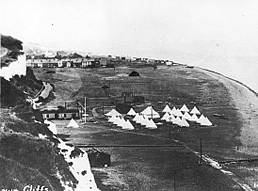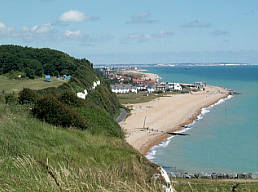Coastal Erosion
As the coastline has been developed and particularly since the development of the eastern section of Dover Harbour at the turn of the century, surveys show that there has been a gradual reduction in the natural supply of shingle from the south. This coupled with the inevitable attrition of the shingle into sand has meant that there has been a steady loss in the volume of material over many years, particularly on the Deal and Kingsdown frontage.
There is however evidence that there are many factors, which drive the movement of shingle and the evolution of the frontage. Drawings of Walmer Castle from the 1700's show the moat to be threatened by the encroachment of the sea and the cliffs to the west of Cliffe Road in Kingsdown must have once been subject to wave action. Both these features are now some 50 metres or so from the current defence line.
The current situation is that of steady erosion along most of the frontage except in the Walmer area where some accretion is occurring. A study of the Deal to Kingsdown coast (June 1997), which was carried out for the council as part of the Coast Defence Strategy, estimated a net movement of sediment out of the study frontage amounting to about 12,000 m3 per year, with only 4,000 m3 per year being transported from the south.
In addition to the gradual retreat of the shoreline, occasional severe storms such as those that occurred in 1897, 1927, 1953, 1956, 1978, 1990 and 1996 cause dramatic loss to the coast and high costs as a consequence of the associated flooding.
Future predictions of the evolution of the coastline if defences were abandoned indicate a general trend of natural retreat from Sandown Castle to the south of Deal Pier. This would lead to the loss of the southern-most defences protecting the extensive Wantsum Channel flood risk zone, which divides Thanet from the rest of Kent. Erosion predicted to the north of Kingsdown would result in the loss of properties located at the rear of the existing beach. Further stretches of slight erosion would also occur between Oldstairs Bay and Hope Point although this area is relatively stable.
Factors affecting and driving Coastal Erosion
There are many variables that affect coastal erosion of which the main controlling factor is that of wave approach which set up onshore and alongshore currents. There are various secondary factors such as the Goodwin Sands and inshore currents but essentially the dominant wind direction over the year together with the orientation of the shore relative to this result in waves approaching the shore at an angle. Consequently, sediment is moved along the coast corresponding to wave direction.
In Kent the predominant direction of offshore wave approach is from the South-west. This is then refracted through the Straights of Dover creating onshore waves from the South-east causing a net movement of material to the north. However the most severe direction for storm activity is from the North-east which can cause occasional reversal of the general trend resulting in significant shingle movements from north to south.
High-energy waves are able to transport larger amounts of sediment. With the Kent Coast predominantly made up of shingle, high wave energy is required and is provided by the long fetch from the South-west and North-east.
Beaches provide the best defence against wave attack, as they dissipate wave energy. However, if the beach is removed the cliffs become exposed to severe erosion and undercutting. The amount of beach material reaching any point depends on the availability of material on the up drift side. Consequently, protection established further down the coast could cause a reduced supply to the north and accelerated erosion.
Until recently coast defence measures were taken to protect existing and planned development, often without taking appropriate account of potential adverse effects on adjacent and remote lengths of coastline.
Now with more detailed studies of littoral drift, and the new policy documents such as Shoreline Management Plans, future proposals have to take into account the long-term effects which proposed defences may have on sections of the coastline down-drift which rely on sediment supply.
Oldstairs Bay, Kingsdown 50 years of change

1949

1999
Contact
Email: propertyservices@dover.gov.uk